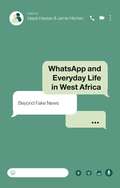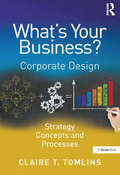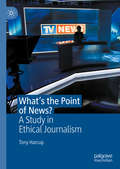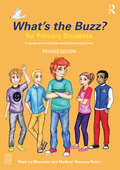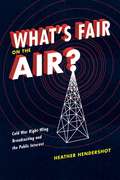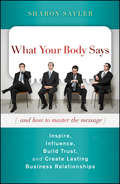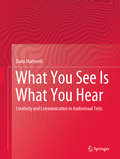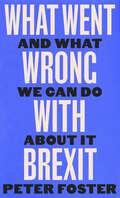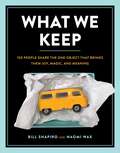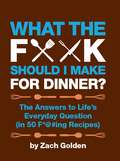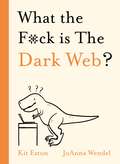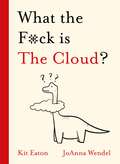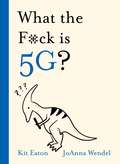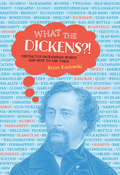- Table View
- List View
WhatsApp and Everyday Life in West Africa: Beyond Fake News
by Idayat Hassan and Jamie HitchenWhatsApp is the most popular messaging platform in over 80% of countries in West Africa, and a daily port of call for a wide range of information and services. This edited collection seeks to examine the impact that this transformative technology has had beyond the much-discussed role it has played in the spread of misinformation, and explore more widely the fundamental changes that WhatsApp has brought to many citizens' lives in social, economic and political contexts.Ranging across subjects including political organisation, religious practice, and family relations, each author in this volume brings direct knowledge and testimony of the impact of WhatsApp across West African society.
WhatsApp and Everyday Life in West Africa: Beyond Fake News
WhatsApp is the most popular messaging platform in over 80% of countries in West Africa, and a daily port of call for a wide range of information and services. This edited collection seeks to examine the impact that this transformative technology has had beyond the much-discussed role it has played in the spread of misinformation, and explore more widely the fundamental changes that WhatsApp has brought to many citizens' lives in social, economic and political contexts.Ranging across subjects including political organisation, religious practice, and family relations, each author in this volume brings direct knowledge and testimony of the impact of WhatsApp across West African society.
What's Your Business?: Corporate Design Strategy Concepts and Processes
by Claire T. TomlinsWhat’s Your Business? offers a comprehensive pathway through the subject of corporate design clarifying the relationship between corporate design and corporate strategy and the terms identity, brand, image, communication and reputation. The book explores the impact of developing digital technology on brand creation and positioning in a marketplace, through symbolic and coherent design. A local market trader may buy a van, promote his business on a blackboard and proclaim ’daily special offers’. Corporations use computers, design websites and communicate with global clients through social media. Yet each business started with an idea and developed a distinctive existence. What’s Your Business? helps you turn a business idea into reality by establishing its existence, ethos, message and activities. By integrating corporate and design strategy with creative inputs Claire Tomlins illustrates the subject’s diversity. She ensures businesses set goals, strategies and plans whilst ensuring they recognise an identity that sparks the corporate design strategy and creative inputs that manifests the company’s aesthetic for marketing purposes; including design management, Intellectual Property topics and measures. Business people wishing to know how design can provide added value to their organisation will find this book useful, including where they could contribute. Academic concepts and definitions are updated and explanations are provided to business and design students on where each of their skillsets can contribute to a business.
What's Your Business?: Corporate Design Strategy Concepts and Processes
by Claire T. TomlinsWhat’s Your Business? offers a comprehensive pathway through the subject of corporate design clarifying the relationship between corporate design and corporate strategy and the terms identity, brand, image, communication and reputation. The book explores the impact of developing digital technology on brand creation and positioning in a marketplace, through symbolic and coherent design. A local market trader may buy a van, promote his business on a blackboard and proclaim ’daily special offers’. Corporations use computers, design websites and communicate with global clients through social media. Yet each business started with an idea and developed a distinctive existence. What’s Your Business? helps you turn a business idea into reality by establishing its existence, ethos, message and activities. By integrating corporate and design strategy with creative inputs Claire Tomlins illustrates the subject’s diversity. She ensures businesses set goals, strategies and plans whilst ensuring they recognise an identity that sparks the corporate design strategy and creative inputs that manifests the company’s aesthetic for marketing purposes; including design management, Intellectual Property topics and measures. Business people wishing to know how design can provide added value to their organisation will find this book useful, including where they could contribute. Academic concepts and definitions are updated and explanations are provided to business and design students on where each of their skillsets can contribute to a business.
What's the Point of News?: A Study in Ethical Journalism
by Tony HarcupThis book questions whether the news we get is as useful for citizens as it could, or should, be. This international study of news is based on re-thinking and re-conceptualising the news values that underpin understandings of journalism. It goes beyond empirical descriptions of what journalism is to explore normative ideas of what it might become if practised alongside commitments to ethical listening, active citizenship and social justice. It draws lessons from both alternative and mainstream media output; from both journalists and scholars; from both practice and theory. It challenges dominant news values by drawing on insights from feminism, peace journalism and other forms of critical thinking that are usually found on the margins of journalism studies. This original and engaging contribution to knowledge proposes an alternative set of contemporary news values that have significant implications for the news industry, for journalism education and for democracy itself.
What's the Buzz? for Primary Students: A Social and Emotional Enrichment Programme
by Mark Le Messurier Madhavi Nawana ParkerWhat’s the Buzz? is an internationally renowned series of programmes designed to help children and young people develop social and emotional awareness. Now available in a revised second edition, What’s the Buzz for Primary Students is a sixteen-lesson programme targeting everyday social challenges faced by primary aged children, such as peer pressure and bullying style behaviours; competition and handling disappointment; feelings and wellbeing and self-awareness. Each lesson is designed around the SAFE criteria (Sequenced; Active; Focused; Explicit) and includes: A new and beautifully illustrated ‘Archie’ story, in which the popular character faces a new and relatable social challenge A series of lively and exciting games and activity suggestions Role-plays and discussion points so that children can put their skills into practice in a supportive environment Having already proven to appeal to teachers and support staff, counsellors and psychologists worldwide, this resource is suitable for anybody looking to enrich the social lives of children. Resources and training modules to support this book can be found on the website www.whatsthebuzz.net.au.
What's the Buzz? for Primary Students: A Social and Emotional Enrichment Programme
by Mark Le Messurier Madhavi Nawana ParkerWhat’s the Buzz? is an internationally renowned series of programmes designed to help children and young people develop social and emotional awareness. Now available in a revised second edition, What’s the Buzz for Primary Students is a sixteen-lesson programme targeting everyday social challenges faced by primary aged children, such as peer pressure and bullying style behaviours; competition and handling disappointment; feelings and wellbeing and self-awareness. Each lesson is designed around the SAFE criteria (Sequenced; Active; Focused; Explicit) and includes: A new and beautifully illustrated ‘Archie’ story, in which the popular character faces a new and relatable social challenge A series of lively and exciting games and activity suggestions Role-plays and discussion points so that children can put their skills into practice in a supportive environment Having already proven to appeal to teachers and support staff, counsellors and psychologists worldwide, this resource is suitable for anybody looking to enrich the social lives of children. Resources and training modules to support this book can be found on the website www.whatsthebuzz.net.au.
What's Fair on the Air?: Cold War Right-Wing Broadcasting and the Public Interest
by Heather HendershotThe rise of right-wing broadcasting during the Cold War has been mostly forgotten today. But in the 1950s and ’60s you could turn on your radio any time of the day and listen to diatribes against communism, civil rights, the United Nations, fluoridation, federal income tax, Social Security, or JFK, as well as hosannas praising Barry Goldwater and Jesus Christ. Half a century before the rise of Rush Limbaugh and Glenn Beck, these broadcasters bucked the FCC’s public interest mandate and created an alternate universe of right-wing political coverage, anticommunist sermons, and pro-business bluster. A lively look back at this formative era, What’s Fair on the Air? charts the rise and fall of four of the most prominent right-wing broadcasters: H. L. Hunt, Dan Smoot, Carl McIntire, and Billy James Hargis. By the 1970s, all four had been hamstrung by the Internal Revenue Service, the FCC’s Fairness Doctrine, and the rise of a more effective conservative movement. But before losing their battle for the airwaves, Heather Hendershot reveals, they purveyed ideological notions that would eventually triumph, creating a potent brew of religion, politics, and dedication to free-market economics that paved the way for the rise of Ronald Reagan, the Moral Majority, Fox News, and the Tea Party.
What's Fair on the Air?: Cold War Right-Wing Broadcasting and the Public Interest
by Heather HendershotThe rise of right-wing broadcasting during the Cold War has been mostly forgotten today. But in the 1950s and ’60s you could turn on your radio any time of the day and listen to diatribes against communism, civil rights, the United Nations, fluoridation, federal income tax, Social Security, or JFK, as well as hosannas praising Barry Goldwater and Jesus Christ. Half a century before the rise of Rush Limbaugh and Glenn Beck, these broadcasters bucked the FCC’s public interest mandate and created an alternate universe of right-wing political coverage, anticommunist sermons, and pro-business bluster. A lively look back at this formative era, What’s Fair on the Air? charts the rise and fall of four of the most prominent right-wing broadcasters: H. L. Hunt, Dan Smoot, Carl McIntire, and Billy James Hargis. By the 1970s, all four had been hamstrung by the Internal Revenue Service, the FCC’s Fairness Doctrine, and the rise of a more effective conservative movement. But before losing their battle for the airwaves, Heather Hendershot reveals, they purveyed ideological notions that would eventually triumph, creating a potent brew of religion, politics, and dedication to free-market economics that paved the way for the rise of Ronald Reagan, the Moral Majority, Fox News, and the Tea Party.
What's Fair on the Air?: Cold War Right-Wing Broadcasting and the Public Interest
by Heather HendershotThe rise of right-wing broadcasting during the Cold War has been mostly forgotten today. But in the 1950s and ’60s you could turn on your radio any time of the day and listen to diatribes against communism, civil rights, the United Nations, fluoridation, federal income tax, Social Security, or JFK, as well as hosannas praising Barry Goldwater and Jesus Christ. Half a century before the rise of Rush Limbaugh and Glenn Beck, these broadcasters bucked the FCC’s public interest mandate and created an alternate universe of right-wing political coverage, anticommunist sermons, and pro-business bluster. A lively look back at this formative era, What’s Fair on the Air? charts the rise and fall of four of the most prominent right-wing broadcasters: H. L. Hunt, Dan Smoot, Carl McIntire, and Billy James Hargis. By the 1970s, all four had been hamstrung by the Internal Revenue Service, the FCC’s Fairness Doctrine, and the rise of a more effective conservative movement. But before losing their battle for the airwaves, Heather Hendershot reveals, they purveyed ideological notions that would eventually triumph, creating a potent brew of religion, politics, and dedication to free-market economics that paved the way for the rise of Ronald Reagan, the Moral Majority, Fox News, and the Tea Party.
What's Fair on the Air?: Cold War Right-Wing Broadcasting and the Public Interest
by Heather HendershotThe rise of right-wing broadcasting during the Cold War has been mostly forgotten today. But in the 1950s and ’60s you could turn on your radio any time of the day and listen to diatribes against communism, civil rights, the United Nations, fluoridation, federal income tax, Social Security, or JFK, as well as hosannas praising Barry Goldwater and Jesus Christ. Half a century before the rise of Rush Limbaugh and Glenn Beck, these broadcasters bucked the FCC’s public interest mandate and created an alternate universe of right-wing political coverage, anticommunist sermons, and pro-business bluster. A lively look back at this formative era, What’s Fair on the Air? charts the rise and fall of four of the most prominent right-wing broadcasters: H. L. Hunt, Dan Smoot, Carl McIntire, and Billy James Hargis. By the 1970s, all four had been hamstrung by the Internal Revenue Service, the FCC’s Fairness Doctrine, and the rise of a more effective conservative movement. But before losing their battle for the airwaves, Heather Hendershot reveals, they purveyed ideological notions that would eventually triumph, creating a potent brew of religion, politics, and dedication to free-market economics that paved the way for the rise of Ronald Reagan, the Moral Majority, Fox News, and the Tea Party.
What's Fair on the Air?: Cold War Right-Wing Broadcasting and the Public Interest
by Heather HendershotThe rise of right-wing broadcasting during the Cold War has been mostly forgotten today. But in the 1950s and ’60s you could turn on your radio any time of the day and listen to diatribes against communism, civil rights, the United Nations, fluoridation, federal income tax, Social Security, or JFK, as well as hosannas praising Barry Goldwater and Jesus Christ. Half a century before the rise of Rush Limbaugh and Glenn Beck, these broadcasters bucked the FCC’s public interest mandate and created an alternate universe of right-wing political coverage, anticommunist sermons, and pro-business bluster. A lively look back at this formative era, What’s Fair on the Air? charts the rise and fall of four of the most prominent right-wing broadcasters: H. L. Hunt, Dan Smoot, Carl McIntire, and Billy James Hargis. By the 1970s, all four had been hamstrung by the Internal Revenue Service, the FCC’s Fairness Doctrine, and the rise of a more effective conservative movement. But before losing their battle for the airwaves, Heather Hendershot reveals, they purveyed ideological notions that would eventually triumph, creating a potent brew of religion, politics, and dedication to free-market economics that paved the way for the rise of Ronald Reagan, the Moral Majority, Fox News, and the Tea Party.
What's Fair on the Air?: Cold War Right-Wing Broadcasting and the Public Interest
by Heather HendershotThe rise of right-wing broadcasting during the Cold War has been mostly forgotten today. But in the 1950s and ’60s you could turn on your radio any time of the day and listen to diatribes against communism, civil rights, the United Nations, fluoridation, federal income tax, Social Security, or JFK, as well as hosannas praising Barry Goldwater and Jesus Christ. Half a century before the rise of Rush Limbaugh and Glenn Beck, these broadcasters bucked the FCC’s public interest mandate and created an alternate universe of right-wing political coverage, anticommunist sermons, and pro-business bluster. A lively look back at this formative era, What’s Fair on the Air? charts the rise and fall of four of the most prominent right-wing broadcasters: H. L. Hunt, Dan Smoot, Carl McIntire, and Billy James Hargis. By the 1970s, all four had been hamstrung by the Internal Revenue Service, the FCC’s Fairness Doctrine, and the rise of a more effective conservative movement. But before losing their battle for the airwaves, Heather Hendershot reveals, they purveyed ideological notions that would eventually triumph, creating a potent brew of religion, politics, and dedication to free-market economics that paved the way for the rise of Ronald Reagan, the Moral Majority, Fox News, and the Tea Party.
What Your Body Says (And How to Master the Message): Inspire, Influence, Build Trust, and Create Lasting Business Relationships
by Sharon SaylerTrain your body to communicate with confidence and clarity-have your body match what your mouth says... The popular phrase "leading from influence" takes for granted that influence derives chiefly from verbal communication. However, communication is about more than words. To get to the next level in your career, you must communicate with your entire self. What Your Body Says gives you the straight-up "how-to" on unifying what you say with what you do, allowing you to better connect with other people and reach your full leadership potential. It gives you a clear and simple process to follow, all drawn from an intense study of how language impacts people's lives and emotions. Filled with useful tools, strategies, and techniques, this book gives you the key to Speak intelligently while looking smart, engaging and real Deliver unpleasant messages without pain or guilt Having a committee meeting and getting something done And more Written by Sharon Sayler, a highly accomplished expert in marketing, presentations, and body language, What Your Body Says is the only guide you need to achieve the competitive edge in your personal and business communication style.
What Your Body Says (And How to Master the Message): Inspire, Influence, Build Trust, and Create Lasting Business Relationships
by Sharon SaylerTrain your body to communicate with confidence and clarity-have your body match what your mouth says... The popular phrase "leading from influence" takes for granted that influence derives chiefly from verbal communication. However, communication is about more than words. To get to the next level in your career, you must communicate with your entire self. What Your Body Says gives you the straight-up "how-to" on unifying what you say with what you do, allowing you to better connect with other people and reach your full leadership potential. It gives you a clear and simple process to follow, all drawn from an intense study of how language impacts people's lives and emotions. Filled with useful tools, strategies, and techniques, this book gives you the key to Speak intelligently while looking smart, engaging and real Deliver unpleasant messages without pain or guilt Having a committee meeting and getting something done And more Written by Sharon Sayler, a highly accomplished expert in marketing, presentations, and body language, What Your Body Says is the only guide you need to achieve the competitive edge in your personal and business communication style.
What You See Is What You Hear: Creativity and Communication in Audiovisual Texts
by Dario MartinelliWhat You See Is What You Hear develops a unique model of analysis that helps students and advanced scholars alike to look at audiovisual texts from a fresh perspective. Adopting an engaging writing style, the author draws an accessible picture of the field, offering several analytical tools, historical background, and numerous case studies. Divided into five main sections, the monograph covers problems of definitions, history, and most of all analysis. The first part raises the main problems related to audiovisuality, including taxonomical and historical questions. The second part provides the bases for the understanding of audiovisual creative communication as a whole, introducing a novel theoretical model for its analysis. The next three part focus elaborate on the model in all its constituents and with plenty of case studies taken from the field of cinema, TV, music videos, advertising and other forms of audiovisuality. Methodologically, the book is informed by different paradigms of film and media studies, multimodality studies, structuralism, narratology, “auteur theory” in the broad sense, communication studies, semiotics, and the so-called “Numanities.” What You See Is What You Hear enables readers to better understand how to analyze the structure and content of diverse audiovisual texts, to discuss their different idioms, and to approach them with curiosity and critical spirit.
What Went Wrong With Brexit: And What We Can Do About It
by Peter FosterONE OF 2023'S BIGGEST NEW BOOKS (GUARDIAN) A FINANCIAL TIMES BEST BOOK OF 2023 A GUARDIAN 'IF YOU READ ONE BOOK ABOUT . . .' POLITICS PICK A WATERSTONES BEST BOOK OF 2023: POLITICS Six years after Brexit, it can feel like we’re still having the same conversations. This is the explainer we need to move on. And we do need to move on, because in the meantime so much has changed. The economic realities that are making the UK less competitive, less productive and less well-off are ever more obvious – and more and more people are finding out the Brexit they were sold was based on falsehoods and fantasy. So what exactly went wrong with Brexit? In this book, Peter Foster dispels the myths and, most importantly, shows what a better future for Britain after Brexit might look like. With clear-headed practicality, he considers the real costs of leaving the EU, how we can recover international trust in the UK, how to improve cooperation and trade with our neighbours, and how to begin to build the Global Britain that Brexit promised but failed to deliver. The politicians won’t talk about it, so we need to.
What We Keep: 150 People Share the One Object that Brings Them Joy, Magic, and Meaning
by Bill Shapiro Naomi WaxWith contributions from Cheryl Strayed, Mark Cuban, Ta-Nahesi Coates, Melinda Gates, Joss Whedon, James Patterson, and many more -- this fascinating collection gives us a peek into 150 personal treasures and the secret histories behind them. All of us have that one object that holds deep meaning--something that speaks to our past, that carries a remarkable story. Bestselling author Bill Shapiro collected this sweeping range of stories--he talked to everyone from renowned writers to Shark Tank hosts, from blackjack dealers to teachers, truckers, and nuns, even a reformed counterfeiter--to reveal the often hidden, always surprising lives of objects.
What the F*@# Should I Make for Dinner?: The Answers to Life's Everyday Question (in 50 F*@#ing Recipes)
by Zach GoldenIf dinnertime has you cursing up a storm, this cookbook of 50 profane and delicious dishes will get you off your indecisive a** and into the f*@#ing kitchen!Derived from the incredibly popular (and totally addictive) website, WhatTheFuckShouldIMakeForDinner.com, this "choose your own adventure" style cookbook provides quick and easy solutions for the nightly conundrum. Every page is a new (and easy) meal, with enough pizzazz to keep you interested. Don't like the recipe? Simply choose another page for a new f*@#ing idea! Making choices is hard, so let this book do it for you with 50 solid meal ideas-and a side of salty language-for meat-eaters and vegetarians alike, such as: Scallop Ceviche Grilled Skirt Steak with Chimichurri Red Flannel Hash Vegetarian CassouletNever hem and haw over what to make for dinner again! What the F*@# Should I Make For Dinner? is the perfect gift for anyone who loves food, and will become your go-to guide to save you from headache, hunger, and your own wishy-washy self.
What the F*@# Should I Make for Dinner?: The Answers to Life's Everyday Question (in 50 F*@#ing Recipes) (A What The F* Book)
by Zach GoldenIf dinnertime has you cursing up a storm, this cookbook of 50 profane and delicious dishes will get you off your indecisive a** and into the f*@#ing kitchen! Derived from the incredibly popular (and totally addictive) website, WhatTheFuckShouldIMakeForDinner.com, this "choose your own adventure" style cookbook provides quick and easy solutions for the nightly conundrum. Every page is a new (and easy) meal, with enough pizzazz to keep you interested. Don't like the recipe? Simply choose another page for a new f*@#ing idea! Making choices is hard, so let this book do it for you with 50 solid meal ideas-and a side of salty language-for meat-eaters and vegetarians alike, such as:Scallop Ceviche Grilled Skirt Steak with Chimichurri Red Flannel Hash Vegetarian Cassoulet Never hem and haw over what to make for dinner again! What the F*@# Should I Make For Dinner? is the perfect gift for anyone who loves food, and will become your go-to guide to save you from headache, hunger, and your own wishy-washy self.
What the F*ck is The Dark Web? (WTF Series)
by Kit EatonWhat the f*ck is the Dark Web, and how does it even work?Whether it's from dodgy acronym-titled crime shows to news stories designed to terrify you down to your socks we've all heard about sites like Silk Road and the ways criminals use cryptocurrency online. But did you know that among the various shady corners of the dark web you can also find portals to the BBC and Facebook?The thing is even the way the everyday internet works is a mystery to us and its darkest corners are, of course, more deeply shrouded. So, let's go on a journey from the birth of the Net through the strangest dark services - need a hitman to bump off your superfluous...er...beloved spouse? - to the surprisingly positive uses of dark technology, including dodging the watchful eye of oppressive censors.Over half of us can't remember a time before the internet - and for the rest it's increasingly difficult to imagine life without the damn thing! It's about time we understood more about it and we can start with the question: What The Fuck is The Dark Web?
What the F*ck is The Cloud? (WTF Series)
by Kit EatonWhat the f*ck is the Cloud, and how does it even work?Ah, The Cloud. It's such a useful bit of tech jargon isn't it? The kind that's casually thrown around in work meetings by bosses who (kind of) understand and maybe even at the nerdier type of dinner or drinks parties. People joke about the cloud while others take it for granted and some worry about this mysterious entity where all of our data is stored, accessible at the touch of a screen from anywhere on Earth. But what even is the cloud, and for that matter, where is the cloud?Join us on a journey from the very first iterations of the internet that we know and (sometimes) love, all the way through thorny issues of data collection and storage (weren't we all fooled by the 'ten years on' social media trend, even as we rely on cloud-stored photos of cats to cheer us up?) and discover the mysterious place where The Cloud ominously hovers.
What the F*ck is 5G? (WTF Series)
by Kit EatonWhat the f*ck is 5G, and how does it even work?The world loves 4G phones, tablets and other gizmos and we take the tech for granted...but when that 4 grew up into the next-gen 5, it seems everyone perked up and started caring about phone networking tech. Journalists journaled, politicians, er, politicked, and tin-foil hat wearers reached for the extra-thick reinforced foil. Why all this fuss? Believe it or not, 5G could change the way you live. Because though it seems like smartphones are only good for tiktok and texting, 5G has the power to revolutionise how we interact with public spaces - from concerts and gigs to coffee shops, paving the way for foundational tech like virtual and augmented reality. This book will explain this missing radio link that will propel us into the future of self-driving cars and VR. Oh, and along the way we'll explore why 5G and coronavirus are very definitely and completely, utterly, not the same thing
What the Dickens?!: Distinctly Dickensian Words and How to Use Them
by Bryan KozlowskiFeaturing the quirkiest specimens in the Dickensian lexicon and culled from Charles Dickens' classic works, What the Dickens?! is a literary romp through the twisty alleyways of the Victorian vernacular. What larks! Dive into the world of literature's ultimate wordsmith, Charles Dickens, in this literary romp through his finest quips, barbs, and turns of phrase.Featuring 200 of Dickens' best-loved words, drawn from his fifteen novels and hundreds of short stories, What the Dickens?! is full of period-appropriate definitions, pithy commentary, and charming illustrations. Perfect for word nerds and book lovers of all ages, this volume will have you dragging your friends to the hippo-comedietta and bonneting your anti-Pickwickian adversaries like a proper Victorian in no time!
What the Dickens?!: Distinctly Dickensian Words and How to Use Them
by Bryan KozlowskiFeaturing the quirkiest specimens in the Dickensian lexicon and culled from Charles Dickens' classic works, What the Dickens?! is a literary romp through the twisty alleyways of the Victorian vernacular. What larks! Dive into the world of literature's ultimate wordsmith, Charles Dickens, in this literary romp through his finest quips, barbs, and turns of phrase. Featuring 200 of Dickens' best-loved words, drawn from his fifteen novels and hundreds of short stories, What the Dickens?! is full of period-appropriate definitions, pithy commentary, and charming illustrations. Perfect for word nerds and book lovers of all ages, this volume will have you dragging your friends to the hippo-comedietta and bonneting your anti-Pickwickian adversaries like a proper Victorian in no time!
